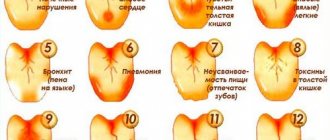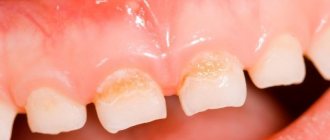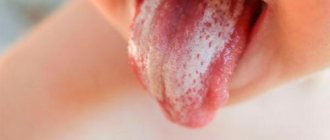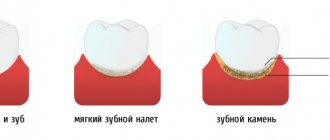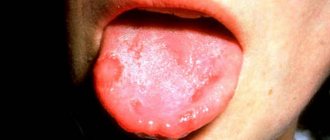.
For parents, children and their health are the most important thing. Every mother begins to panic when she sees the sad state of the child, the pale appearance of the face, the color of the tongue is different than before. The baby's tongue is very sensitive to the external environment. Its mucous membrane always reacts to taste factors, allergies, antibacteriosis and other phenomena. From this it can acquire a plaque. Based on its color, the doctor diagnoses possible diseases. Where does a child’s brown tongue come from and how can it threaten a child’s health?
Brown tongue in children may be a sign of a serious illness
What is plaque on the tissues of the tongue?
We will divide the reasons for the formation of layering into groups:
- anatomical;
- hygienic:
- medicinal.
The tongue as an anatomical organ of a person is unique in that its mucous membrane is covered with an epithelial cover with formations in the form of papillae. They help us taste food. They are also easily susceptible to the destructive effects of microbes and bacteria. Therefore, epithelial cells become obsolete, peel off, replacing themselves with young cells. But it happens that this process is inhibited by the upper layers of the epithelial membrane, which, during the active change of cells, die, but do not crumble, forming a coating on the tongue.
The cause of plaque is the use of strong antibiotics
Black teeth in children: possible complications
Black teeth look unsightly. In childhood, this can affect self-esteem. Also, a person with this problem has bad breath. In addition, ignoring this symptom can lead to a number of complications. Among them:
- caries;
- periodontitis;
- increased sensitivity of teeth;
- bleeding gums;
- gingivitis.
To eliminate plaque and prevent its reappearance, it is enough to simply teach your child to follow the rules of hygiene. But it’s better not to take risks - get tested and rule out bad options.
Types of plaque
A similar phenomenon happens to everyone: both children and adults. We don’t even think about healthy plaque and don’t pay attention to it. It appears more or less depending on the time of year. In the summer, when the period of berries, fruits, and vegetables begins, the layer on the tongue is quite noticeable, since it has different shades:
- white;
- yellow;
- green;
- even dark blue.
In winter, plaque is not visible on a healthy body.
Yellow coating on the tongue occurs due to liver diseases
Why does plaque appear on the tissues of the tongue?
The appearance of dense plaque is often a symptom of a disease in the body. As soon as you notice that your tongue has become coated with a layer of distinctive color, you should be careful.
Thick plaque will indicate chronic diseases and complex infections.
Therefore, it is important to identify the cause of its formation in time. Especially when it comes to the health of the child.
Medical terminology
In medical practice, the following types of plaque stains are distinguished:
- diffuse,
- local.
A diffuse appearance occurs when the entire surface of the tongue is covered with a colored layer. The local type involves the formation of plaque on a specific area of the mucous membrane.
Diffuse plaque covers the entire tongue
In addition, the accumulation can have a different structure: be wet or dry, have a curd-like shape. Soft plaque can be quickly removed by scraping off with a toothbrush or a special scraper. A hard scraper is more dangerous and requires medical intervention.
How does plaque appear on a child’s tongue?
A brown coating on a child’s tongue occurs due to insufficient oral hygiene. It seems that infants cannot have such a problem, because they have no teeth and nothing to brush, but they also need to clean their mouth after breastfeeding. Kids learn to explore the world, so they taste everything, in this way they introduce different microorganisms to themselves.
Medications also provoke the appearance of a bacterial layer.
A newborn in the outside world is not protected from diseases and infections. In especially difficult cases, mothers have to turn to medicinal treatments. As a result, the child may develop an allergy to drugs, pathogenic microflora in the mouth, which reveals itself with a coated tongue.
Causes of brown plaque
Most often, a newborn's tongue becomes white or yellow. In the first case, it acquires color due to the formation of thrush, but quickly renews and passes. In the second case, the baby may have problems with the liver, which results in jaundice.
Brown plaque is less common and seems to be a more dangerous phenomenon for the child’s health, especially if it appears on the tongue of an infant.
Brown plaque in teenagers is due to hormonal changes
Doctors name the following reasons for a brown tongue:
- Disturbance of gastrointestinal processes, digestive problems.
- A state of dehydration resulting from elevated temperature or low fluid levels in the body.
- Lack of B vitamins.
- Ingestion of fats, food poisoning.
- Reaction to certain medications.
Coca-Cola turns your tongue brown
There is another reason that is not related to the biological nature of the body. This reason is somewhat banal, but it is not uncommon - eating brown foods:
- chocolate;
- caramels;
- soda;
- dark berries, etc.
A change in the appearance of the tongue occurs during the reaction of dyes with the mucous membrane. After all, parents are not always able to control their children’s consumption of foods with dyes. Buckwheat porridge can also leave a dark tint.
Shades of brown plaque
Due to problems with the digestion of the body, the tongue can acquire a brown color of different shades: light brown, yellow-brown and dark brown. When diagnosing a child, the doctor asks to show the tongue and by the shade he can find out the type of disease and its cause.
Layer light brown
A light brown color of the tongue will indicate a problem with the respiratory tract or lymph inflammation.
Digestive problems are the cause of yellow-brown plaque
Layer yellow-brown
The causes of yellow-brown plaque are more related to diseases of the stomach and intestines. The main reasons include:
- Inflammatory processes of the duodenum.
- Cases of bile entering the gastric tract.
- Cases of hepatitis.
- Prolonged dehydration due to vomiting or diarrhea.
A dark brown layer on the epithelium of the mucous membrane indicates that the child may have problems with the kidneys, liver, and gall bladder.
Tooth decay in children can cause plaque on the tongue
If you notice the appearance of a layer of brown plaque in any shade on your baby’s tongue, it is better to immediately consult a doctor.
Plaque for the little ones
A brown coating on a baby's tongue is a cause of concern, as this is not typical for him. The first and main reason for this phenomenon will be the introduction of complementary foods into food, when the mother’s milk is no longer sufficient. Taking complementary foods is not an easy process for a newborn’s body. He still can't get used to the new nutrients. Brown plaque is the baby’s body’s reaction to supplements.
A newborn's coated tongue may indicate bowel problems and even a lung problem.
But in such cases, mothers should pay attention to the child’s temperature. If a child has a fever and at the same time there is a brown coating on the tongue, it is necessary to call an ambulance in order to provide qualified assistance in a timely manner.
A yellow coating appears in infants with the start of complementary feeding
Examination of a child in the clinic
Self-medication by parents can end in failure. For proper consultation, you should contact your pediatrician, who will determine the cause and method of preventing infection.
It is important to consider the location of plaque on the tongue in newborns. If the accumulation is visible at the tip, this may indicate a problem with the functioning of the lungs, and may be a sign of bronchial disease. If the layering does not disappear within 2-3 days, this may be a manifestation of an infectious disease such as scarlet fever or influenza. In the form of symmetrical spots, it is a symptom of incipient pneumonia. A brown layer in the center of the tongue is a clear sign of a gastrointestinal disease. In the specialized literature, the concept of “geographical” language is found - this is when plaque spots are localized along the surface in different parts. This kind of coating may indicate infection of the baby’s body with worms.
A consultation with a dentist will help identify the cause of the plaque.
Diagnosis of the disease
In a hospital examination, an accurate diagnosis is established after a general and biochemical blood test, an antibody test, a scraping from the mucous membrane of the tongue, and a urine and stool test. Other studies may be needed: ultrasound of the stomach and intestines, respiratory tract, fiberoscopy and gastroscopy, etc.
Chocolate stained tongue
Depending on the detected test results, parents should consult a doctor: gastroenterologist, toxicologist, infectious disease specialist. If a child’s baby teeth begin to erupt or are already clearly visible, then you should definitely show them to the dentist; sometimes the reason is that the baby has carious teeth.
Pathological causes
If the plaque is not washed off, the child becomes capricious, other warning signs appear, and pathological changes take place. Among the diseases and conditions that have a symptom in the form of coating of the tongue, the following pathologies are distinguished.
Candidiasis or thrush
Thrush is a lesion of the mucous membranes of the throat by fungi of the genus Candida.
Candidiasis in breastfed babies occurs for the following reasons:
- non-compliance with breast hygiene of mother and child;
- infection during delivery;
- weakening of the baby's immunity.
Characteristic symptoms of candidiasis are the coating of the tongue with a dense white coating of a cheesy structure. The rashes tend to spread throughout the entire throat cavity. The child becomes restless and refuses to breastfeed. The plaque cannot be washed off with water; wipe it off with a gauze swab. If it is possible to remove the cheesy deposits, bleeding spots remain or redness is noted at the site of removal.
To treat stomatitis, you can try two main effective methods:
- washing the mouth with soda water (wiping several times a day);
- washing with a honey-water solution (you should soak the bandage in the solution and wipe the mucous membranes of the pharynx).
Honey should be used with caution due to the high risk of allergic reactions. Relief should come after a few days. If therapeutic measures do not bring results, you should consult a doctor to prescribe medication.
Plaque due to viral infection
Infectious diseases in 90% of cases are caused by a coated tongue. With acute respiratory viral infections, acute respiratory infections, and colds, there is a white coating, decreased appetite, the baby is capricious, there may be an increase in body temperature, and copious discharge of mucus from the nasal passages.
The following diseases are characterized by the appearance of a specific plaque:
- diphtheria - a dirty gray or whitish coating localized on the root and back of the tongue, palatine arches and pharynx;
- dysentery - the appearance of a thick white coating with erosive foci;
- scarlet fever - a grayish-white coating on the tongue with severe swelling and hyperemia.
When the plaque is thick, there are always traces of the woman's pacifier or nipple. In case of infectious diseases, plaque appears in the first days, after which it gradually disappears.
Treatment of infectious diseases is symptomatic and medicinal. Special measures to remove plaque on the tongue are usually not taken due to its subsequent spontaneous disappearance.
Allergy
An important etiological factor that causes a white coating on the tongue of an infant.
The most common pathological immune reactions are allergic diathesis and chronic stomatitis. They are the main causes of white spots on the baby's tongue.
In this case, the allergy manifests itself in the form of islands of plaque on the scarlet mucous membrane, similar to a “geographic tongue.” This picture is due to impaired regeneration of the papillae covering the back of the tongue.
Slowing down the regeneration of the surface epithelium is a sufficient reason for the appearance of red spots - areas on the “map”.
Only an allergist can identify the allergic agent, help prevent its contact with the child and prescribe treatment.
It is often necessary to consult a gastroenterologist, since such a clinical picture may also be characterized by the presence of hypoacid gastritis.
Chronic aphthous stomatitis is an autoimmune process that is provoked by allergization of the body due to opportunistic bacteria of the digestive tract, viruses, and food-borne antigens.
Diseases that may be complicated by aphthous stomatitis include:
- colitis and enteritis;
- biliary dyskinesia;
- dysbacteriosis;
- gastritis;
- helminthic infection (in everyday life - worms);
- chronic diseases of the ENT organs (frequent otitis, rhinitis, pharyngitis, tonsillitis);
- bronchial asthma.
A pediatrician talks in detail and informatively about what dysbiosis is in infants and how to treat such a condition.
Digestive disorders and dysbiosis
Dysbacteriosis is understood as the predominance of pathogenic microflora over opportunistic microflora, a kind of imbalance. This condition is more typical for babies older than 3 months who have entered the period of complementary feeding with adapted formulas and the introduction of pureed food ingredients.
The main symptoms of dysbiosis in a breastfed baby are:
- abnormal stool (unusual impurities, foam, frequent, too loose stools);
- the appearance of a white coating on the root of the tongue;
- excessive regurgitation;
- bad breath.
Treatment consists of prescribing prebiotic complexes that will restore the ratio of healthy microflora and eliminate the unpleasant manifestations of pathology. All medications and vitamins are prescribed strictly by a pediatrician.
Pathologies of the digestive system
Diseases of the epigastric and digestive organs are quite rare in children less than one year old. Usually there is a confirmed intrauterine pathology (anomalies of organ development, anatomical features).
The main symptoms in breastfeeding infants are:
- excessive regurgitation;
- slight coating of the tongue that cannot be removed by rubbing and drinking water;
- severe colic;
- problems with weight gain;
- rumbling;
- stool disorders.
If the edge of the baby's tongue turns bright purple, then the development of gastroenterological diseases can be suspected. Treatment is usually symptomatic and requires supervision by a pediatrician and other specialists in the relevant field.
Fungal infection
The development of thrush in the child’s mouth occurs as a result of the growth of Candida fungi. Intensive reproduction of pathogenic microorganisms occurs as a result of the influence of various factors.
Often babies become infected with thrush during childbirth, crossing the birth canal
These include:
- Weakened immune system.
- Dysfunctions of the microflora of the gastrointestinal tract.
- Hormonal disorders.
- Conducting antibacterial therapy.
- Excessive dryness of the oral mucosa.
Infection with Candida fungi occurs under the following conditions:
- In utero. Infection can occur through the placenta, umbilical cord and amniotic fluid.
- During childbirth. Often babies become infected with thrush during childbirth, crossing the birth canal. Therefore, it is important for women to exclude the development of thrush, especially in the last stages of pregnancy.
- Finding a child in a hospital and maternity hospital. Inappropriate and non-sterile care of the child contributes to the child becoming infected from health care workers.
- Poor sanitary conditions at home. Babies are born with a weakened immune system. Therefore, keeping a child in an unsterile home environment promotes the penetration of various microorganisms and bacteria into his body.
This is interesting: The jaw hurts near the ear on the left
Diagnosis of candidal glossitis involves a complete collection of anamnesis data and conducting various types of comprehensive research.
Important! In most cases, when diagnosing thrush in a child, an instrumental examination is not performed.
For these purposes the following is carried out:
- Microscopic examination of the oral mucosa by taking a scraping from plaque and then examining it under a microscope. This allows you to determine the presence of Candida mycelium threads and yeast-like cells.
- Bacteriological research. Allows you to identify the type of Candida fungus and the number of its colonies. Sowing mushrooms on a nutrient medium helps install the most effective antifungal drug. This is necessary, since many medications have different effects on grown fungal colonies.
- Serological study. It is carried out if necessary to study antibodies that are concentrated in the blood serum.
Gastritis with high acidity
In this case, a white coating is noticeable in the middle part of the tongue. You won't be able to delete it either. This symptom will be accompanied by frequent regurgitation of milk mixed with gastric juice and a characteristic sour odor. If your baby accidentally swallows the formula back, it will irritate the esophagus and the baby will start crying. Regurgitation in infants occurs immediately or within an hour after feeding.
You are unlikely to be able to determine the cause of the increase in acidity on your own, so contact a specialist. He will analyze the situation and give the necessary recommendations.
Stomatitis and diseases of the mucous membranes of the pharynx
Stomatitis develops as a result of infection of the mucous membranes of the throat. A common cause of pathology is the entry of pathogenic microflora into the mouth through toys, various objects, and fingers. Insufficient maternal hygiene during breastfeeding is also a cause of stomatitis.
Symptoms of the disease are:
- the appearance of white sores;
- white coating on the tongue, inner surface of the cheeks, gums;
- loss of appetite and breast refusal (sucking causes severe pain);
- moodiness and crying.
If left untreated, stomatitis progresses, ulcers grow, and new ones appear, which is a serious problem for the child. Local gels, ointments are prescribed, and for generalized forms, systemic treatment.
Dehydration
Lack of fluid in a child’s body is a life-threatening condition caused by a number of internal or external factors. Acute dehydration is a symptom of various infectious diseases of a viral or bacterial nature, intestinal infections, when a child suffers from frequent bowel movements, vomiting or regurgitation.
The condition requires immediate hospitalization of the child, as symptoms of dehydration in infants increase rapidly.
Chronic dehydration can be caused by chronic diseases of the kidneys, urinary system, long-term use of diuretics, and other medications. In this case, symptomatic treatment is carried out aimed at replenishing the water balance in the body.
One of the symptoms is the appearance of a whitish or yellowish dry coating on the tongue without clinical symptoms.
The main danger of dehydration lies in the increase in electrolyte disturbances in the blood. At the same time as the liquid, potassium, magnesium, phosphorus, calcium, fluorine, chlorine and other compounds important for the growth and development of the child are excreted.
Iron-deficiency anemia
Anemia is characterized by a decrease in the number of red blood cells in the blood and a lack of iron supply to the brain. Up to 6 months, anemia in a child is physiological in nature and does not require special treatment. Therapy begins at stage II of anemic syndrome.
The main symptoms are:
- vomit;
- decreased appetite;
- the formation of a white coating and pallor of the tongue;
- paleness of the skin;
- the appearance of bruises under the eyes.
For treatment, iron-containing drugs are prescribed as prescribed by a doctor. With increasing anemia, it is important to consult a hematologist. Anemia caused by a different nature is treated according to the underlying disease of the internal organs.
The mother should include beef meat, meat by-products, beets, pomegranates, and beef liver in her diet when breastfeeding.
Weakened immunity
Up to six months, the child’s body is protected by maternal immunity. As it grows, its own is formed. Reduced immunity in a young child is a consequence of genetic predisposition, certain diseases of organs and systems, and frequent colds.
Symptoms of an immunodeficiency state in infants are frequent colds and infectious diseases with complications, stressful situations, hypothermia, pale skin, and white coating on the tongue.
As therapy, vitamin complexes are prescribed, the diet, sleep, and wakefulness are reviewed.
All medications for the treatment of various diseases that could cause white plaque in a baby during breastfeeding should be prescribed only by a doctor. Rapidly growing symptoms and the infant's anxious state are always treated in a hospital setting.
No home recipes, self-medication, or advice from experienced friends should become a signal to action. The child’s body is still imperfect, so it can only provoke serious complications, including sudden death.
The main danger of an unremovable white coating on the tongue of a baby when breastfeeding a baby lies in the true cause of its occurrence. If the disease is serious, then the lack of adequate therapy often leads to chronicity of the pathological process.
The timely reaction of parents to changes in the child’s condition is an important reason for an unscheduled visit to a pediatrician.
Prevention of brown plaque on the tongue
We have already found out the reasons for the appearance of a brown coating on a child’s tongue. But how can you prevent this symptom? Rules should be followed to prevent all kinds of diseases associated with changes in the color structure of the tongue. These rules are stated by doctors all over the world, and they are also often voiced by the famous doctor Komarovsky. The rules are simple, but must be followed systematically:
- The room where there is a child must always be clean and tidy; the room should be ventilated, the air humidified.
- At the first appearance of a brown plaque, the mother should call a doctor rather than try to cure the symptom on her own (whether using medication or grandma’s folk remedies).
Oral hygiene - prevention of plaque formation
You need to constantly monitor your baby's condition. If you notice a plaque, think about what the child has been given to eat recently, what he has taken, how he is doing with the toilet, and whether he has a fever. If you notice a connection with foods, try reducing the dose for a couple of days or completely removing it from your diet. Then check to see if the natural color of the tongue has returned. The main thing is to establish in time the tendency towards darkening and thickening of the plaque layer.
If your child already indulges in sweets, limit the amount of colored foods: candy, marmalade, soda. All this food has a destructive effect on the child’s body, including the epithelium of the tongue.
Prevention measures
Never forget about hygiene rules. In relation to a newborn child, they must be observed especially carefully:
- Wash your hands with soap every time before handling your baby. Even if you are not going to feed him, but just hold him.
- Wash your breasts and nipples well before each feeding. If you have cured candidiasis in a child, there is still a risk of relapse, since the fungus can get back to the baby from the breast. For prevention, it is allowed to treat the breasts with a soda solution. If it dries out the skin of your nipples, use an emollient cream.
- Sterilize nipples, pacifiers, bottles and all utensils you use for feeding. Keep toys clean, as babies put everything in their mouth. Minimize the chance of germs entering your baby's mouth.
- Make sure that the saliva in your baby's mouth does not dry out. To do this, maintain the required air humidity and optimal temperature. The room should be warm, but not hot.
Try to follow one more rule of hygiene. No matter how much you love your baby, don't kiss him on the lips. This creates a high probability that you will transmit to him not only the candida fungus, but also the herpes virus, as well as other bacteria and microbes to which you already have immunity, but, alas, the child has not yet developed it.
Sources:
- https://kinders.online/bd/belyj-nalet-na-yazyke-u-novorozhdennogo-pri-gv-norma-i-priznaki-patologii-osobennosti-klinicheskoj-kartiny-i-lechenie.html
- https://LechenieDetej.ru/zuby/nalet-na-yazyke.html
- https://Detky.ru/malysh/zdorovje-malysha/belyi-nalet-na-yazyke
- https://kroha.info/health/disease/belyj-nalet-na-yazyke-u-rebenka
- https://dentoland.com/polost-rta/nalet/belyj-na-yazyke-u-grudnichka.html
- https://VseProRebenka.ru/zdorove/simptomy/belyj-nalet-na-yazyke-u-grudnichka.html
- https://kcdc.ru/deti/belyj-nalet-na-yazyke-u-grudnichka.html
How to treat brown plaque?
It is difficult to talk about the treatment of brown plaque, since it is not a separate disease, but only a symptom. No doctor will recommend any medications or procedures to cure a coated tongue. It is not the symptom that needs to be treated, but the disease.
The main diseases that manifest themselves with similar indicators include:
- Gastritis.
- Stomach ulcer.
- Infection.
- Weakened immunity.
- Oral diseases.
Only a specialist doctor can make a correct diagnosis and prescribe appropriate treatment. It will identify high-quality antibiotics. It happens that he prescribes a topical medication such as tretinoin. After the course of treatment, the appearance of brown color on the tongue will disappear.
The drug Tretionin is prescribed by a doctor for treatment
Nature of occurrence
The appearance of a whitish coating is provoked by multiple factors.
All reasons are conditionally classified into two main groups:
- natural (physiological);
- pathological (caused by any disease).
Physiological reasons never affect the general condition of the child, do not worsen his well-being, and do not cause any negative reactions in the form of constant crying, pain during feeding, or breast refusal.
When pathologies occur, plaque is a characteristic symptom reflecting the general somatic condition of the child. Usually, after eliminating the root cause and symptomatic treatment, all unpleasant manifestations go away.
